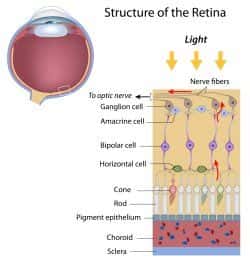Fuchs' dystrophy (pronounced fooks DIS-truh-fee) is an eye disease characterized by degenerative changes to the cornea’s innermost layer of cells. The cause for Fuchs' dystrophy is not fully understood. If your mother or father has the disease, then there is roughly a 50 percent chance that you will
Read more
Retinal disorders are conditions that affect the layer of tissue at the back of the eye, known as the retina. This important part of the eye responds to light and passes on images to the brain. All retinal disorders affect your vision in some way, but some can also lead to blindness.
Macular degeneration. Also known as age-related macular degeneration (AMD), this condition affects the center part of the retina, the macula. This area is needed for the sharp, central vision that is used during everyday activities such as driving, reading or working with tools. This condition is a leading cause of vision loss in people over the age of 60 years old. Treatment can slow the loss of vision, but it will not restore vision that has already been lost.
Diabetic eye disease. The high blood sugar (glucose) levels that occur with diabetes can also affect vision. One type of diabetic eye disease is diabetic retinopathy, which affects the blood vessels in the retina. This can lead to blurry or double vision, blank spots in the vision and pain in one or both eyes. Diabetics may also be at higher risk of developing other eye conditions, such as cataracts and glaucoma.
Retinal detachment. This medical emergency happens when the retina pulls or lifts off of its normal position. It can cause symptoms such as floaters in the field of vision, light flashes and the feeling of a “curtain” in the way of your vision. If not treated right away, a retinal detachment can lead to permanent blindness in that eye.
Retinoblastoma. This cancer of the retina is generally uncommon; although, it is the most common type of eye cancer in children. The cancer starts in the cells of the retina, but can spread to other parts of the body (metastasize).
Macular pucker. Scar tissue on the macula can make the central vision become blurry and distorted. Although the symptoms are similar, macular pucker is not the same as age-related macular degeneration. The symptoms of a macular pucker are usually mild and do not require treatment. Sometimes, the scar tissue can fall off the retina on its own, and the vision will return to normal.
Macular hole. This condition is caused by a small break in the macula, which leads to blurriness and distortion in the central vision. Related to aging, this condition usually happens in people over the age of 60. Some macular holes close up on their own while others require surgery to help improve vision.
Floaters. These are specks, or “cobwebs,” that appear in the field of vision. Unlike scratches on the cornea, which follow your eye movements, floaters can drift even when the eyes are not moving. Most people have some floaters and have no problem with their vision. A sudden increase in the number of floaters, though, can indicate a more serious eye problem such as retinal detachment.
If you notice a change in your vision or simply have not undergone a routine eye ex
-
Fuchs' Corneal DystrophyCategory: Eye Diseases
-
Bifocal ContactsCategory: Contact Lenses
Bifocal contact lenses are a type of contact lens that combine two different prescriptions in the same lens. One component corrects nearsightedness and the other prescription addresses farsightedness or farsightedness. Several types of bifocal contacts are available; your eye care provider can help you
Read more -
Contact Lens FAQCategory: Contact Lenses
Can I wear contact lenses? Most people are able to wear contact lenses safely and comfortably. There are contact lenses that correct for nearsightedness, farsightedness, astigmatism, and other vision problems. An optometry exam can determine what lenses are appropriate for you. Are contact lenses safe
Read more -
Pinguecula and Pterygium (Surfer's Eye)Category: Common Eye Conditions, Changes in Appearance
Characterized by a yellowish raised part of the scleral conjunctiva (the lining of the white part of the eye), a pinguecula usually develops near the cornea (colored part of the eye), but does not extend past it. Similar to a callus on the skin, changes in tissues lead to the buildup of calcium, fat,
Read more -
Macular DegenerationCategory: Common Eye Conditions, Age-Related
One of the most important reasons for regular examinations by your eye care provider is evaluate for the development of macular degeneration. According to the Bright Focus™ Foundation, this condition is the primary cause of loss of vision and blindness in older individuals ages 60 and above and is
Read more -
CataractsCategory: Common Eye Conditions, Age-Related
Many body parts begin to change as you age, and your eyes are no exception. One of the most common age-related eye changes is the development of cataracts. Although cataracts do not occur exclusively in older adults, they affect approximately half of all Americans by age 80. What Are Cataracts? Cataracts
Read more -
UveitisCategory: Common Eye Conditions, Cognitive and Acquired
Uveitis refers to the inflammation of the eye's middle layer, which consists of the iris, ciliary body, and choroid. Several fungal, viral, or bacterial infections lead to uveitis, as do certain autoimmune (systemic) and inflammatory conditions. In most cases of uveitis, however, the exact cause is unknown. Types
Read more -
Computer Vision SyndromeCategory: Common Eye Conditions, Cognitive and Acquired
Almost everyone uses computers in the modern world, whether for recreation, employment, education or any combination of the three. Unfortunately, our increased use of computers in almost every aspect of our lives -- even using a smartphone to make a telephone call -- requires our eyes to read a computer
Read more -
StrabismusCategory: Common Eye Conditions, Cognitive and Acquired
Commonly called crossed eyes, strabismus is a condition in which eyes do not work together, failing to maintain proper alignment. While one eye focuses on an object, the other does not. The failure of the eyes to work together causes double vision, and if untreated can lead to an extreme reduction of
Read more -
GlaucomaCategory: Common Eye Conditions, Age-Related
Glaucoma is the second leading cause of blindness in the United States, making it an important public health priority. Although there are several factors that cause glaucoma, all types of glaucoma are characterized by damage to the optic nerve. This damage prevents the brain from receiving appropriate
Read more -
Sjogren's SyndromeCategory: Common Eye Conditions, Cognitive and Acquired
Pronounced SHOW-grins, Sjogren's syndrome is a disorder of the immune system, or an autoimmune disease, which causes the body's immune system to attack and harm the body's glands. Your glands are responsible for the production of saliva, tears, and other lubrication necessary for the proper function
Read more -
Optic NeuritisCategory: Common Eye Conditions, Cognitive and Acquired
Also known as demyelinating optic neuritis, optic neuritis refers to the inflammation of the optic nerve due to the loss of or damage to a protective covering called myelin, which surrounds the optic nerve. The myelin is essential to the function of the optic nerve. A more general term, optic neuropathy,
Read more -
Eye OcclusionsCategory: Common Eye Conditions, Cognitive and Acquired
An eye occlusion is a blockage in one of the arteries or veins supplying blood to the retina and/or optic nerve. These blockages can cause severe and sudden vision loss. Contact your eye care professional immediately if you experience sudden vision loss, and follow up right away with your family doctor.
Read more -
AstigmatismCategory: Common Eye Conditions, Cognitive and Acquired
Many correctable vision problems are caused by abnormal eye anatomy. Very few people have perfectly shaped eyes that facilitate ideal vision. Rather, most people have some degree of abnormal curvature or other anatomical irregularities that cause slight visual changes. Astigmatism is one common form
Read more -
StyeCategory: Common Eye Conditions, Eye Lids
A stye, sometimes spelled as "sty," is a red, painful bump near the edge of the eyelid. It may look like a pimple or abscess, and it can form on the inside or outside of the eyelid. A stye is actually a localized infection that usually disappears by itself after a few days, although in rare cases, a
Read more -
ChalazionCategory: Common Eye Conditions, Eye Lids
A chalazion is the medical term for a slowly developing lump on the eyelid that occurs due to an oil gland blockage. At first, the eyelid may appear to be red, tender and swollen. After several days, the chalazion will form on the eyelid, appearing as a slow growing lump. While it is initially painless
Read more

